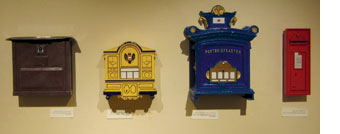The Alexander Museum of Postal
History & Philately
 The history of human communications is
as long as the history of humankind. Before the invention of
writing people communicated by consensual signs. Nevertheless, the
writing revolution made it possible to send complex and personal
messages to faraway places. Thus, the post and its assorted
elements were created: the writer, the letter, the messenger and
the addressee.
The history of human communications is
as long as the history of humankind. Before the invention of
writing people communicated by consensual signs. Nevertheless, the
writing revolution made it possible to send complex and personal
messages to faraway places. Thus, the post and its assorted
elements were created: the writer, the letter, the messenger and
the addressee.
In biblical sources there is evidence of letters and epistles, and
'doar,' the Hebrew word for post, in the sense of sending letters,
can be found in the Talmud. The word 'post' was used as early as
Ancient Rome.
Postal history is interrelated with the development of human
society and serves as a mirror for the various stages, revolutions,
and changes that took place in global history. An important
watershed was reached in 1840 when the first postal stamp - the
Penny Black - was issued in England. Thus postal services became
useful and available to all. These services were further developed
with the Industrial Revolution and the progress in land and sea
transportation. Following England other countries began printing
their own stamps, and to date close to a million stamps have been
issued throughout the world.
In their design stamps manifest the spirit and values of the
times and its cultural and artistic styles. Stamps as a visual text
that transfers a succinct graphical message have become
collectibles throughout the world.

The Alexander Museum of Postal History and Philately tells the
postal history of the Land of Israel against the backdrop of the
historical, social and political changes in the region. The exhibit
comprises postal history in general, and local postal history in
particular, employing interactive multimedia.
The
Lobby
Communications and postal services
There are three identical stamps, in different shades, exhibited
in the pavilion lobby, depicting the development of communications
- from ancient times when pottery and papyrus served for writing
letters, through today's electronic mail. The "Red Ford" in the
center of the exhibit, bearing the Israel Post's emblem of the
running stag, is a Ford F1 dating from 1949, the kind of vehicle
that served the Israel Post in its early days.
A special corner is devoted to special temporary exhibits
related to the history of philately and postal services in
Israel.
The Historical
Gallery
The history of the postal services in our country
The exhibit unfolds as a historical gallery, beginning with the
Ottoman Period and ending withDoar Ivri[Hebrew Post], and is
divided into windows that describe the post offices that operated
in the country.
 In Eretz Israel, which was part of the
Ottoman Empire, the first stamps were used in the1860s. From this
time on, in addition to the Turkish postal services, independent
post offices of European countries such as Austria, France and
Germany also provided service. They operated under concessions
granted by the Empire to manage and organize the civil life of
citizens of these countries in matters concerning economy, law, and
religion. Thus, enhanced transportation and postal services were
provided, among them the distribution of mail by postmen and the
installation of street mailboxes. With the outbreak of World War I
in 1914 these post offices closed down.
In Eretz Israel, which was part of the
Ottoman Empire, the first stamps were used in the1860s. From this
time on, in addition to the Turkish postal services, independent
post offices of European countries such as Austria, France and
Germany also provided service. They operated under concessions
granted by the Empire to manage and organize the civil life of
citizens of these countries in matters concerning economy, law, and
religion. Thus, enhanced transportation and postal services were
provided, among them the distribution of mail by postmen and the
installation of street mailboxes. With the outbreak of World War I
in 1914 these post offices closed down.
At the beginning of the 20th century themoshavot mail
also operated; it served the new Jewishyishuv [the Jewish
settlement], and the first Hebrew stamp was issued - the stamp of
the "Mother of the Moshavot", Petach Tikva. Postal services
improved during the British Mandate: impressive and innovative post
offices opened in Jaffa and Jerusalem, and a stamp series that
showed the landscapes and sites of the country was introduced into
service. Towards the end of the Mandate all postal services were
terminated.Minhelet Ha'am [the provisional government], that led
theyishuv, re-operated them in most parts of the country, thus
laying the foundations for the Israel Post.
The first stamps of the State of Israel were printed
clandestinely, before the name of the nascent state was known. They
were issued on May 16, 1948, two days after the declaration of
independence, and bore the wordsDoar Ivri.These stamps showed
motifs taken from Hebrew coins from the days of the Second Temple
and Bar Kochkva. The choice of ancient motifs manifested the link
between the history of the Jewish People and its rebirth in the
country in modern times.
Mezzanine
Current postal services
A computerized system situated in the center of the halls
demonstrates the postal services today. Visitors can use different
information menus related to the activities of the Postal Company
and up-to-date postal services, and learn about their immediacy and
complexity.
Morse code machines, teleprinters, and field telephones, which
can be viewed on this level, demonstrate the use made of
technological innovations for transmitting messages. Electrical
signals transmitted via cables were transformed into signs by the
Morse code machine, into print by teleprinters, and sounds by the
field telephone.
Two interactive computerized stations offer the visitor a
comprehensive collection of Israel's stamps. Shifting the
"magnifying glass" over the screen makes it possible to choose a
series of screens that deal with the stamp itself and other stamps
on the same topic.
Upper
level
The Stamp Album and the Printing Machine
"The Stamp Album" in the eastern part of the pavilion exhibits a
selection of stamps in chronological order, through which visitors
can learn about the design style and the different topics in
Israeli stamps that changed over the years.
TheDoar Ivristamps were printed clandestinely on the adjacent
printing machine, which was used to print theHaaretznewspaper in
Sarona, Tel Aviv. On the adjacent screen visitors can watch a film
describing the process of stamp production today.
In this space there are also temporary exhibitions devoted to
diverse historical topics.
The Lower
Floor
The Alexander Collection
Stamp collector Zvi Alexander assembled this important
collection over 50 years, which is devoted to the Holy Land postal
history. The collection is composed of unique philatelic items and
covers 600 years of the history of Eretz Israel. It represents
important chapters dealing with geo-political and socio-economic
aspects: the pre-philatelist era, the Turkish post, foreign post
offices, World War I, the development of Zionism and themoshavotin
Eretz Israel, the British Mandate, the War of Independence,
and the establishment of the State of Israel. Special emphasis is
placed on the connection between world Jewry and Eretz Israel and
the Zionist enterprise.
The significant and outstanding items in the Alexander
Collection are exhibited in the Philately Wing, which comprises
historical collections and all the stamps of Israel. In this
section visitors have access to a library, a lecture hall, a room
for creative activities. In the Jaglom Library a collection of
philatelic items devoted to towns and sites in Eretz Israel is on
show; it covers some 150 years, from the Ottoman Empire until the
present day.
The museum was inaugurated in 1998 by the Israel Postal
Authority, the Tel Aviv Foundation and the Eretz Israel Museum, Tel
Aviv